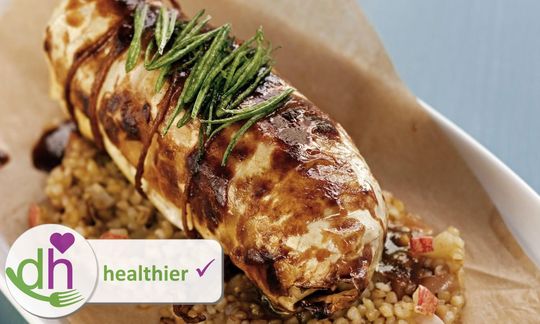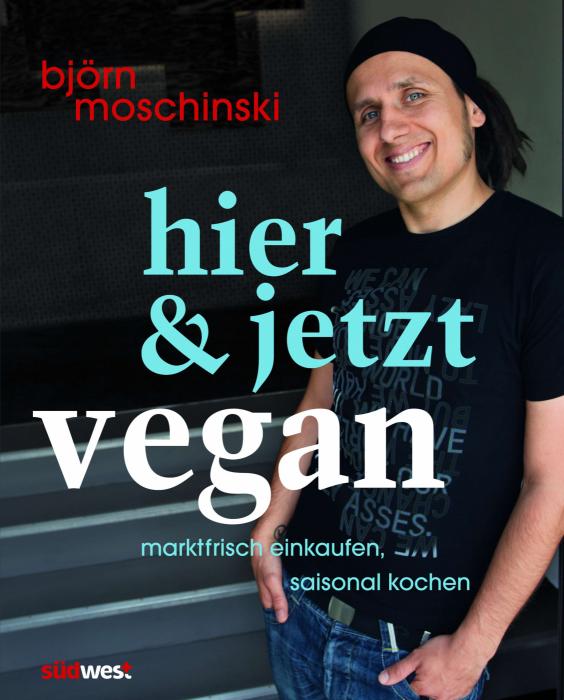Healthy vegan cabbage rolls with apple-celery-bulgur
vegan
Ingredients (for servings, )
Equipment
- Küchengarn or Rouladenklammer (Rouladenspange)
- vegetable peeler
- skillet (frying pan)
- citrus juicer (lemon squeezer)
- saucepan
- oven
- casserole dish (baking dish)
Type of preparation
- cook
- chop or grind
- braised
- soak
- sauté
- sieve
- squeeze
- dry roast
- season to taste
- can (bottle)
- sauté
- deglaze
- peel
- rinse with cold water
- binden (ficellieren)
Preparation
For the bulgur
Put the bulgur in a bowl. Bring the vegetable stock to the boil and pour enough into the bowl to just cover the bulgur. After about 10 minutes, loosen the bulgur.The 200 ml vegetable stock is only an approximate amount. Use enough to barely cover the bulgur.
Motivation (apple symbol) and link to the original recipe can be found directly above the recipe picture.
Peel the shallot, dice it and fry it in a pan with the hot oil until translucent.
Core the apples and cut into fine cubes. Squeeze the lemon(s) with a citrus press and drizzle the juice over the apples.
Add the apple pieces sprinkled with lemon juice to the still warm bulgur. Season with salt and cayenne pepper.
For the sauce
Peel the onions and chop them roughly. Clean the carrot, leek and celery, chop them into large pieces and put them in a hot pan with the oil.In contrast to the original recipe, we halved the amount of rapeseed oil.
Gently fry the vegetables until they turn a dark brown (not black!) color. Now reduce the heat slightly, add the tomato paste and sauté for about 3 minutes.
The rapeseed oil should be heated to a maximum of 180 °C. Under no circumstances should it start to smoke (see alternative preparation).
Deglaze with a quarter of the red wine and allow to reduce. Repeat this once more and then pour in the remaining red wine and the vegetable stock.
Add the bay leaves and allspice and cook until the desired consistency and strong flavor are achieved. Then pass the sauce through a sieve and season with salt.
For the cabbage rolls
Bring a large pot of water to the boil. Remove the outer leaves and the stalk from the white cabbage and cook the cabbage in the water until the first leaves come off. Rinse the loosened leaves in cold water. Repeat the process until 8-12 leaves have come off. Remove the thick stalk.Peel and dice the onion and garlic. Soak the soya granules according to the instructions on the packet and fry with oil and diced onion. Season with salt, pepper and garlic and then leave to cool.
In contrast to the original recipe, we replaced 40 ml of sunflower oil for 4 portions with
20 ml of rapeseed oil.Mix the seitan powder (wheat gluten) with toast, oat cream, tomato paste and mustard into the soy granules. Season with salt and pepper.
In the original recipe, soy cream is used instead of oat cream, and we also used homemade tomato paste. You can find a link to the corresponding recipe under "Alternative preparation".
Wrap the filling in 2 or 3 leaves each and hold or tie together with a roulade clip or a thread (kitchen twine).
If you don't have any roulade clips or thread, a roulade needle or other skewer-like utensils could also help to hold the roulades together.
Peel the shallots and place them in a baking dish with the cabbage rolls, pour over some gravy and braise in the oven on the middle shelf at 180 °C for 30 minutes.
Arrange the roulades, bulgur, shallots and sauce on plates and serve hot.
|
Nutritional Information per person
Convert per 100g
|
2000 kcal | |
|---|---|---|
| Energy | 794 kcal | 39.7% |
| Fat/Lipids | 24 g | 34.9% |
| Saturated Fats | 2.5 g | 12.3% |
| Carbohydrates (inc.dietary fiber) | 110 g | 40.7% |
| Sugars | 33 g | 36.5% |
| Fiber | 27 g | 109.2% |
| Protein/Albumin | 37 g | 74.6% |
| Cooking Salt (Na:364.5 mg) | 926 mg | 38.6% |
| Essential micronutrients with the highest proportions | per person | 2000 kcal | |
|---|---|---|---|
| Vit | Vitamin K | 369 µg | 492.0% |
| Vit | Vitamin C (ascorbic acid) | 177 mg | 222.0% |
| Min | Manganese, Mn | 3.6 mg | 181.0% |
| Vit | Vitamin B9, B11 (Folate, as the active form of folic acid) | 358 µg | 179.0% |
| Prot | Tryptophan (Trp, W) | 0.33 g | 134.0% |
| Min | Copper, Cu | 1.3 mg | 126.0% |
| Prot | Threonine (Thr, T, irreversibly transaminated) | 1.00 g | 107.0% |
| Elem | Potassium, K | 2'080 mg | 104.0% |
| Fat | Alpha-Linolenic acid; ALA; 18:3 omega-3 | 2.1 g | 104.0% |
| Vit | Vitamin B6 (pyridoxine) | 1.3 mg | 90.0% |
Detailed Nutritional Information per Person for this Recipe
The majority of the nutritional information comes from the USDA (US Department of Agriculture). This means that the information for natural products is often incomplete or only given within broader categories, whereas in most cases products made from these have more complete information displayed.
If we take flaxseed, for example, the important essential amino acid ALA (omega-3) is only included in an overarching category whereas for flaxseed oil ALA is listed specifically. In time, we will be able to change this, but it will require a lot of work. An “i” appears behind ingredients that have been adjusted and an explanation appears when you hover over this symbol.
For Erb Muesli, the original calculations resulted in 48 % of the daily requirement of ALA — but with the correction, we see that the muesli actually covers >100 % of the necessary recommendation for the omega-3 fatty acid ALA. Our goal is to eventually be able to compare the nutritional value of our recipes with those that are used in conventional western lifestyles.
| Essential fatty acids | per person | 2000 kcal |
|---|---|---|
| Alpha-Linolenic acid; ALA; 18:3 omega-3 | 2.1 g | 104.0% |
| Linoleic acid; LA; 18:2 omega-6 | 7.6 g | 76.0% |
| Essential amino acids | per person | 2000 kcal |
|---|---|---|
| Tryptophan (Trp, W) | 0.33 g | 134.0% |
| Threonine (Thr, T, irreversibly transaminated) | 1.00 g | 107.0% |
| Isoleucine (Ile, I) | 1.1 g | 87.0% |
| Phenylalanine (Phe, F) | 1.2 g | 80.0% |
| Valin (Val, V) | 1.2 g | 75.0% |
| Leucine (Leu, L) | 1.8 g | 74.0% |
| Lysine (Lys, K, irreversibly transaminated) | 1.2 g | 66.0% |
| Methionine (Met, M) | 0.39 g | 42.0% |
| Vitamins | per person | 2000 kcal |
|---|---|---|
| Vitamin K | 369 µg | 492.0% |
| Vitamin C (ascorbic acid) | 177 mg | 222.0% |
| Vitamin B9, B11 (Folate, as the active form of folic acid) | 358 µg | 179.0% |
| Vitamin B6 (pyridoxine) | 1.3 mg | 90.0% |
| Vitamin B1 (Thiamine) | 0.73 mg | 66.0% |
| Vitamin B7 (Biotin, ex vitamin H) | 24 µg | 48.0% |
| Vitamin E, as a-TEs | 5.0 mg | 42.0% |
| Vitamin A, as RAE | 329 µg | 41.0% |
| Vitamin B5 (Pantothenic acid) | 2.4 mg | 40.0% |
| Vitamin B3 (Niacin) | 5.3 mg | 33.0% |
| Vitamin B2 (Riboflavin) | 0.42 mg | 30.0% |
| Essential macroelements (macronutrients) | per person | 2000 kcal |
|---|---|---|
| Potassium, K | 2'080 mg | 104.0% |
| Phosphorus, P | 562 mg | 80.0% |
| Magnesium, Mg | 256 mg | 68.0% |
| Sodium, Na | 364 mg | 46.0% |
| Calcium, Ca | 341 mg | 43.0% |
| Essential trace elements (micronutrients) | per person | 2000 kcal |
|---|---|---|
| Manganese, Mn | 3.6 mg | 181.0% |
| Copper, Cu | 1.3 mg | 126.0% |
| Iron, Fe | 8.3 mg | 59.0% |
| Zinc, Zn | 3.3 mg | 33.0% |
| Selenium, Se | 11 µg | 19.0% |
| Fluorine, F | 175 µg | 5.0% |
| Iod, I (Jod, J) | 3.9 µg | 3.0% |
Südwest-Verlag München / Bassermann / Irisiana Verlagsgruppe Random House GmbH, Björn Moschinski
Raw recipes 3 (1), Cooked recipes 57 (6)
Additional photos (12)
The cookbook "here & now vegan" by Björn Moschinski shows us seasonal cuisine with market-fresh local ingredients, some of which can be found directly in nature.
Since this book is written in German, a description is omitted here. If you are interested, please switch to German in the menu.
The healthy cabbage rolls with apple-celery-bulgur are a filling meal. Their fruity note gives them a touch of lightness.
New nutrient profile: According to GDA guidelines, one portion of this recipe covers five times the average daily requirement of vitamin K, twice the average daily requirement of vitamin C and more than the daily requirement of manganese and folic acid. In addition, the dish contains a good ratio of omega-6 to omega-3 fatty acids, which in this case (4:1) complies with the recommended 5:1 ratio.
Roulade: The word "roulade" originally comes from the French-speaking area and is derived from "rouler" (i.e. "to roll"). In gastronomy, this is used to describe filled rolls made up of slices of meat, fish or, as in this recipe, cabbage leaves, which are braised in a stock or a suitable sauce. The names for roulades vary depending on the region. For example, the term "Fleischvogel" is common in the south of the German-speaking area when referring to meat roulades, and those made from cabbage leaves are called "Wickel".
Spice information: The amounts of salt, pepper, allspice and cayenne pepper are approximate and should be dosed individually according to taste. But especially with salt, "less is more".
Organic carrots: If you use organic vegetables, you do not need to peel the carrots.
Prepare your own vegetable stock: You can find vegetable stock as a ready-made product in many large supermarkets. Nevertheless, making your own vegetable stock is relatively straightforward. The ingredients can be adapted to suit your taste and allow you to optimally cover individual taste requirements. We also recommend making your own, especially with regard to artificial additives or preservatives in low-quality ready-made products. You can find the instructions for a stock we have put together under the following link: Vegan vegetable stock.
Avoid processed products, reduce oil:
Instead of soy cream, we use oat cream. You can either buy this in an organic supermarket, or you can easily make it yourself. Follow the following link. The advantage here is that you can do without both soy and processed products. We also used rapeseed oil instead of sunflower oil and reduced the amount from 40 ml to 20 ml. Cold-pressed rapeseed oil is not suitable in this case, as cold-pressed oils can only be heated slightly, in the case of cold-pressed rapeseed oil up to a maximum of 120 °C, otherwise harmful substances are created. See the following link ( cold-pressed rapeseed oil ). But even refined rapeseed oil should only be heated to a maximum of 180 °C. Under no circumstances should it start to smoke, although decomposition will begin beforehand.
Read more: Vegans often eat unhealthily. Avoidable nutritional mistakes.
Homemade tomato paste: We deliberately used homemade tomato paste. If you are in a hurry, you can use ready-made, unsalted organic tomato paste. The following link will take you to a simple recipe for making your own tomato paste:
Homemade tomato paste




